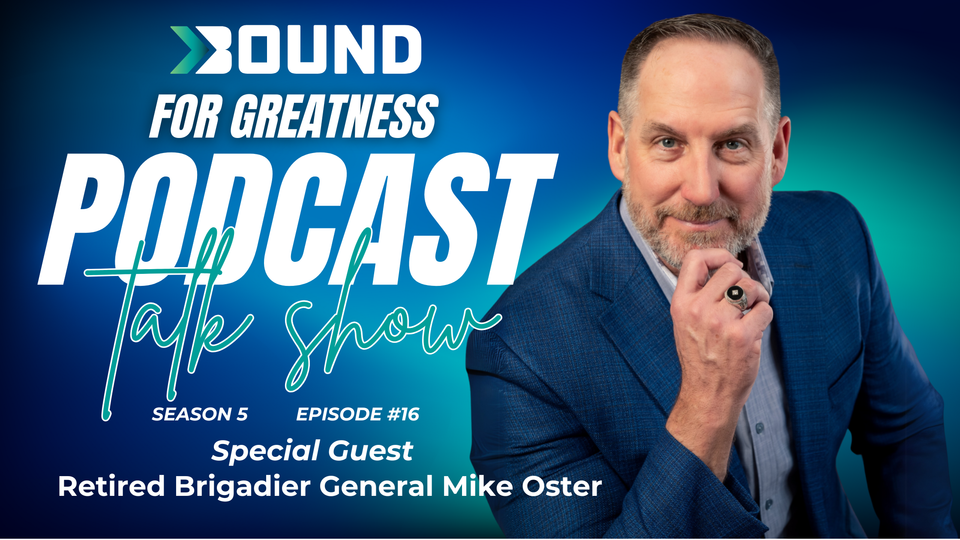Make Excellence Your Average: with Retired Brigadier General Mike Oster

Lead Before the Chaos: How a General’s Battlefield Wisdom is Shaping the Future of Education-Based Athletics”
By Scott Garvis C.M.A.A. NHSACA Executive Director of Finance
When Brigadier General Mike Oster walks into a room, he doesn’t command attention with ego. Instead, it’s the quiet confidence of someone who’s seen the worst of humanity and still chooses to lead with clarity, compassion, and courage. It’s the presence of a man who’s walked battlefields, sat in boardrooms, and now stands in school gymnasiums and leadership conferences delivering one simple, powerful message: leaders aren’t born, they’re built.
Oster’s voice, calm, deliberate, and filled with conviction, was the latest to echo across the Bound for Greatness podcast, hosted by renowned athletic administrator Scott Garvis. In an era where leadership is often confused with charisma or titles, this conversation was a masterclass in what real leadership looks like: deliberate, developed, and driven by purpose.
From the Battlefield to the Locker Room
The parallels between military service and sports culture are as old as both institutions themselves. But few people embody that bridge quite like Mike Oster.
Having led troops in high-pressure combat zones, Oster’s transition to leadership coaching might sound like a pivot. In truth, it’s a continuation. Whether it’s platoons or athletic departments, his mission remains unchanged: equip people to lead before the moment of chaos.
“Leadership has to happen before the event,” Oster explained on the podcast. “If you’re waiting for the moment to lead, the game, the crisis, the meeting, it’s already too late. That’s when chaos takes over.”
Preparation isn’t a military luxury; it’s a necessity. And that principle, Oster insists, is universal. Whether you're coaching a high school team or leading a corporate board, the need to rehearse responses, cultivate accountability, and establish values before pressure hits is what separates elite teams from average ones.
Leading with Courage, Not Comfort
Oster doesn’t sugarcoat the realities of leadership. “It’s easy to lead when things are going great,” he said. “The test comes when things get hard, when tough conversations are needed, when people aren’t meeting expectations. That’s when leaders either rise or retreat.”
Too many leaders, he warns, fall into the trap of “leading with comfort.” They avoid confrontation, protect feelings, and mistake silence for compassion. “But it’s actually cheating the people who are looking to you for leadership,” Oster said. “The hard right is still the right.”
And yet, his vision of courageous leadership doesn’t equate to cold, hard decisions. “You can make the hard right and still lead with compassion,” he added. “Yelling and screaming doesn’t define strength. Courage does. Clarity does. Kindness does.”
Oster’s framework resonates deeply with coaches and athletic directors, many of whom face daily decisions involving personnel, parent conflicts, or student discipline. In these moments, he emphasizes that courage isn’t about being tough, it’s about being honest, consistent, and anchored to a purpose.
Clarity: The Missing Ingredient
Oster’s military lessons are rooted in simplicity, and perhaps his most practical insight is also the one that most school and sports leaders forget: the power of clarity.
“Teams don’t fall apart because of a lack of talent,” he said. “They fall apart because of a lack of clarity.”
When purpose is foggy, when roles are undefined, and when core values are just posters on the wall instead of lived behaviors, that’s when culture collapses. Oster insists that leaders at all levels must ask two questions: Why are we doing this? And does everyone understand it?
That’s not just organizational wisdom; it’s psychological safety. “If people understand the mission, and they helped create the mission, they will hold each other accountable,” Oster said. “Because now it’s not a top-down mandate. It’s ours. And we live it.”
Garvis agreed, noting that in his years of experience as an AD, the most effective cultures were always the most consistent ones. “You walk into those places and you can feel it, the mission is lived, not laminated.”
Holding People Accountable with Heart
Accountability. It’s a buzzword in both business and athletics. But Oster brings a fresh perspective, one that begins not with critique, but with appreciation.
“If I’m only pointing out what people are doing wrong, they tune me out,” he said. “But if I’m also catching them doing things right, and letting them know I see them, then I’ve earned the right to call them up when they’re not bringing their best.”
Oster calls this the “earn before you burn” method. It’s not about being soft. It’s about being credible. “You have to appreciate people before you can correct them,” he said.
Garvis jumped in with agreement, referencing how this approach works especially well in high school environments where relationships with students and coaches are foundational. “You want to create a place where people feel safe enough to grow, and challenged enough to improve,” he said.
Oster nodded. “Exactly. The best accountability comes from within. But it starts with a leader modeling what excellence looks like, and what it doesn’t.”
Why “Why” Always Matters
One of the most memorable moments in the episode was Oster’s emphasis on why. As he told it, everything, strategy, culture, success, flows from understanding your purpose.
Drawing from Simon Sinek’s well-known principle, Oster took it even further: “It’s not just about knowing your why once. You have to ask it every single day. Why am I showing up again today? Why does this matter?”
For Oster, this personal interrogation is what prevents complacency. It’s what fuels consistency. And it’s what keeps leaders grounded when the grind becomes overwhelming.
His wife, a pharmacist, was his example. “Every day, she makes decisions that impact people’s lives,” he said. “That’s purpose. That’s clarity.”
But for Oster, so does a coach. So does an AD. So does a teacher. “If you’re not whistling when you walk into school,” he quoted his brother, a lifelong educator, “then you’re in the wrong place.”
From Uniform to Influence
Transitioning out of the military wasn’t easy. Oster admitted that shedding the structure, authority, and even the salutes came with an identity shift. “You take the uniform off, and you quickly realize, nobody’s standing up for you anymore,” he said with a laugh.
But what he lost in formal command, he gained in relational influence. “In the military, you can order someone to do something. But that’s not leadership. Leadership is when people follow because they want to.”
Today, Oster is invited to speak across the country to educators, executives, and students. His presentations aren’t flashy. They’re filled with stories, stories that cut through the noise and remind people why they chose leadership in the first place.
Lead Up, Lead Down, Lead Around
One of Oster’s most powerful frameworks is what he calls “multi-directional leadership.” That is: you don’t just lead those below you. You lead beside you. You even lead up.
He recalled a mentor once telling him, “Sometimes, you have to point your leader and shoot.” Meaning, even when you’re not at the top, you can influence the direction, if you do it the right way.
Leadership, Oster emphasized, is not about rank. It’s about impact. And impact has no hierarchy.
“I’ve learned just as much from people I’ve led as I have from those I followed,” he said. “That’s the mark of a real leader, someone who’s always learning.”
Building Teams That Would “Follow You to the Gates of Hell”
Perhaps the highest compliment Oster ever received came not with a medal or promotion, but from a chaplain.
“He said to me, ‘Sir, these people would follow you to the gates of hell.’ That’s when I knew we had built something special,” Oster shared.
What created that kind of loyalty? It wasn’t fear. It wasn’t discipline. It was clarity, connection, and shared purpose.
And in a world that often seeks shortcuts to culture, gimmicks, gimmicky hashtags, motivational posters, Oster’s message is refreshingly old-school.
Build trust. Earn respect. Prepare relentlessly. Lead with love.
Living Where Excellence Is Your Average
In the podcast’s final moments, Garvis asked a profound question: “What drives you to keep showing up every day?”
Oster didn’t hesitate. “To live where excellence is my average.”
It wasn’t about being perfect. It was about showing up with intention, understanding your mission, and recognizing the sacred responsibility of leadership — especially when working with youth.
“Every day, whether you know it or not, you’re modeling something,” Oster said. “So why not model excellence?”
It was a reminder that in this era of viral trends and fleeting attention spans, what truly endures are the quiet, consistent acts of leadership. The ones that don’t make the highlight reel, but make all the difference.
Legacy in Action
Brigadier General Mike Oster may have left the battlefield, but make no mistake: he’s still in the fight. Not for medals, but for meaning. Not for power, but for purpose.
As Garvis closed the episode, he summed it up perfectly: “Leadership isn’t about titles. It’s about responsibility, clarity, and courage. And leaders like Mike remind us that the legacy we leave is written not in moments of ease, but in the moments we choose to lead anyway.”
For athletic directors, coaches, educators, and leaders of all stripes, Oster’s challenge is clear: lead with purpose. Lead with love. And above all, lead before the chaos. Because the time to lead is now.

Member discussion